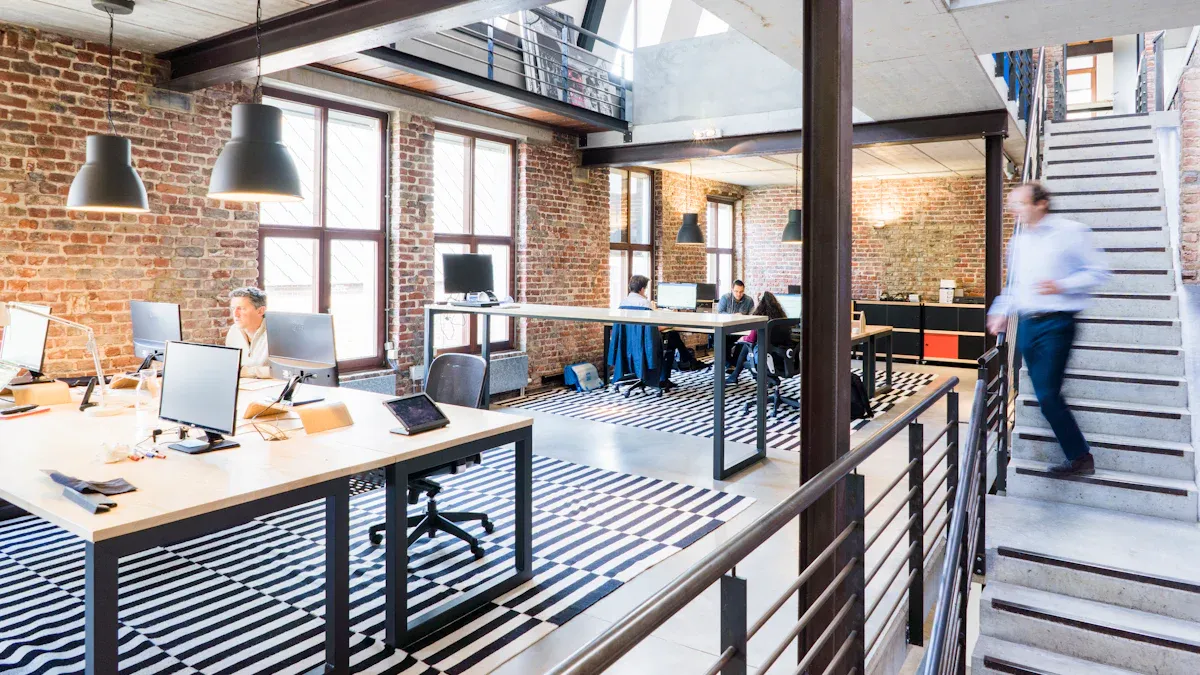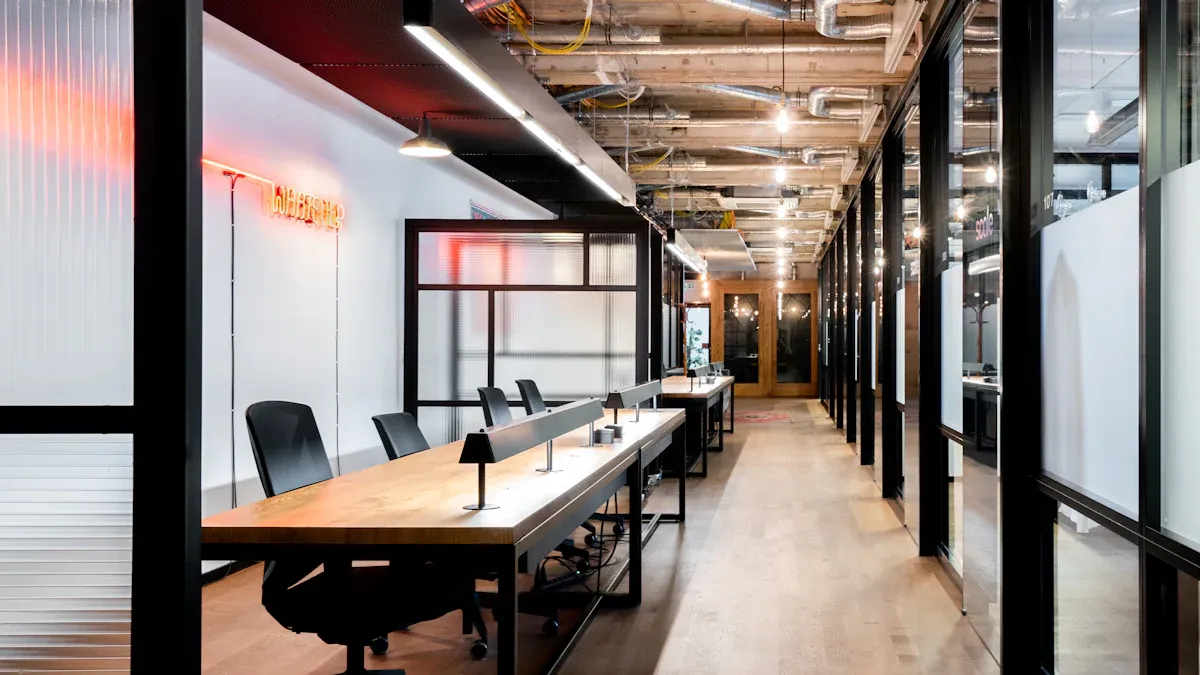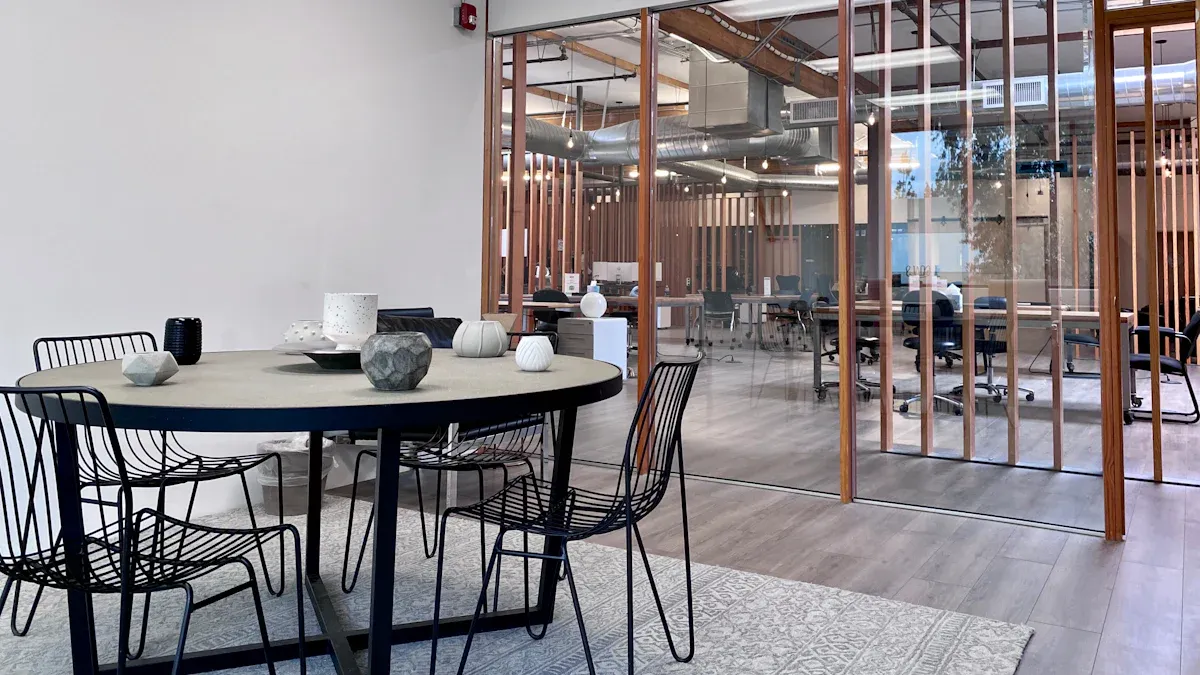Cutting-Edge Solutions for Modern Commercial Spaces

Modern workspaces need cutting-edge solutions to fit changing business needs. Using advanced products can make spaces useful, green, and easy to use. For instance, smart energy systems may grow to $103.9 billion by 2028. This shows more people want better technology. Also, 70% of companies plan to use automation soon. This highlights the move toward modern tools. Adding solar lights or using new designs boosts efficiency and improves experiences.
Key Takeaways
Use AI and IoT to make tasks easier and save energy.
Try AR and VR tools to work together and design better.
Install smart systems to cut energy use and save money.
Pick green materials for building to help the planet and stay healthy.
Get comfy furniture and flexible spaces to work better and feel happy.
Cutting-Edge Technology Innovations

AI and IoT for Smart Space Management
AI and IoT are changing how businesses manage spaces. These tools give instant updates, automate tasks, and save resources. For example, AI-powered video tools help improve operations by giving useful tips. IoT sensors check energy use, helping reduce waste and make HVAC systems better. Systems using real-time data predict problems, cutting downtime and making machines last longer.
One example is The Edge in Amsterdam, where AI controls lights and temperature to save energy. Another is 45 Broadway in New York City, which cut HVAC energy use by 15.8% with AI tools. These technologies make spaces work better and support eco-friendly goals.
Application | What It Does |
|---|---|
Video Tools | Improves operations with helpful insights. |
Smart Building Systems | Saves energy and makes spaces comfortable. |
Predictive Tools | Uses data to prevent problems early. |
Example | Location | Benefit |
|---|---|---|
The Edge | Amsterdam, Netherlands | AI saves energy with smart controls. |
45 Broadway | New York City, USA | HVAC energy use dropped by 15.8%. |
Living Tomorrow | Vilvoorde, Belgium | Shows AI's role in being eco-friendly. |
Using AI and IoT helps create smarter spaces that fit your needs.
AR/VR for Collaboration and Design
AR and VR are changing teamwork and design in workspaces. These tools let you see designs clearly and fix mistakes faster. For example, Airbus used AR to speed up design checks and save money. Teams can work together from anywhere, viewing designs in real size, which boosts creativity and results.
Studies show AR/VR helps people work better. One study by Ren et al. (2016) found bigger views make tasks easier. Another by Terrier et al. (2018) showed fewer errors improve work speed. These studies prove AR/VR can change how teams design and work together.
Study | Focus | Findings |
|---|---|---|
Ren et al. (2016) | Bigger views help tasks | Larger views make work easier. |
Terrier et al. (2018) | Fewer errors improve work | Fixing errors speeds up tasks. |
Adding AR/VR to your work process makes teamwork faster and designs better.
Smart Systems for Energy Efficiency
Smart systems help save energy in modern workspaces. IoT tools like energy trackers and motion sensors cut waste and improve usage. For example, smart lights can save up to 80% of energy. IoT sensors in stores save about 18% on average.
Energy Saving Method | Savings Percentage |
|---|---|
Energy tracking with IoT | 8%–10% |
Smart lighting systems | Up to 80% |
Motion sensors with IoT | 20%–40% |
These systems also lower costs. Buildings report saving 15-20% on peak energy charges and 25-30% on repairs. Using these tools reduces expenses and helps the planet.
Metric | Impact |
|---|---|
Lower Peak Energy Costs | 15-20% savings reported by buildings |
Less Energy Waste | Up to 20% less energy wasted |
Lower Repair Costs | 25-30% drop in repair expenses |
Smart systems are key to creating spaces that save energy and money.
Cutting-Edge Sustainable Design
Eco-Friendly Materials for Construction
Eco-friendly materials are changing how buildings are made. They are better for the planet and people. Materials like reused wood, bamboo, and recycled steel cut waste and lower pollution. For example, in 2011, U.S. low-rise buildings used 1.2 billion board-feet of lumber. This shows how much sustainable materials can help. Energy-saving materials can also cut energy use by 20-30%. This makes them a smart choice for saving money over time.
Examples show the benefits of using eco-friendly materials. In Rongcheng City, China, wood and thatched roofs improved health and helped the environment. Resorts in Mulshi, India, and Maragogi, Brazil, used green materials to improve insulation and health. These examples prove that eco-friendly materials make spaces healthier and better for the planet.
Case Study | Location | Eco-Friendly Materials Used | Health and Environmental Benefits |
|---|---|---|---|
Rongcheng City | Shandong Province, China | Timber, thatched roof | Better health and sustainability |
Mulshi | Maharashtra, India | Various green materials | |
Maragogi | Brazil | Eco-friendly construction | Better insulation and health |
Using eco-friendly materials helps create spaces that care for people and nature.
Modular Construction for Scalability
Modular construction is a fast and cost-saving way to build. It uses pre-made parts built off-site and put together on-site. This method can cut building time by 50%. Projects using modular building save 20% per square foot and make clients 25% happier.
There are some challenges, like rules and design limits. But using Building Information Modeling (BIM) with modular methods can save 8% more money and finish projects 12% faster. These benefits make modular construction a great choice for growing businesses.
Metric | Value |
|---|---|
Shorter project timelines | 30% |
Cost savings per square foot | 20% |
Faster build time | 50% |
Happier clients | 25% |
Revenue growth | 15% |

Modular construction is a smart way to build quickly and save money.
Renewable Energy Integration
Renewable energy is key to green building design. Solar panels, wind turbines, and geothermal systems cut fossil fuel use and save money. For example, 62% of office buildings could use no extra energy with solar power. Energy Star tracks energy and water use for 25% of U.S. commercial buildings, showing more places are using renewable energy.
Examples show how renewable energy helps. The Edge in Amsterdam uses 70% less electricity than normal buildings. It also has a top BREEAM score of 98.4% and is energy-neutral. The Empire State Building updated its systems to use 40% less energy, saving $4.4 million each year. These examples show how renewable energy makes buildings greener and cheaper to run.
Case Study | Key Features and Measurable Outcomes |
|---|---|
The Edge, Amsterdam | - BREEAM score of 98.4% |
Empire State Building | - 40% less energy use |
Adding renewable energy to your building saves money and helps the planet.
Cutting-Edge Furniture and Layouts

Ergonomic Furniture for Productivity
Ergonomic furniture helps workers stay comfortable and work better. Chairs with back support, adjustable desks, and monitor stands lower health problems. These problems often come from sitting too long or bad posture. Studies show using ergonomic furniture can boost work output by 17%. This happens because workers feel less pain and can focus more.
More companies now want ergonomic furniture to help their teams. Offices and hospitals are leading the way in using these designs. By choosing ergonomic furniture, you can make your workspace healthier and more productive.
Key Benefits of Ergonomic Furniture:
Helps improve posture and ease back pain.
Makes it easier to focus and get work done.
Supports long-term health for employees.
Flexible Layouts for Multi-Use Spaces
Flexible layouts change how businesses use their spaces. These setups make desks more useful and encourage teamwork. Multipurpose areas with movable furniture can switch between meetings, rest zones, or idea-sharing spots. For example, tech companies use open spaces to build community and flexibility.
Shared workspaces also show why flexible layouts are helpful. They let businesses share tools and use space better. By using flexible layouts, you can create a space that fits many needs.
Advantages of Flexible Layouts:
Cuts down on the need for private offices.
Helps teams work together and share ideas.
Makes better use of available space.
Integrated Control Systems for Operations
Integrated control systems make managing workspaces easier. They connect lighting, heating, cooling, and security into one system. This saves money and makes things run smoothly. Research shows businesses using these systems grow revenue 60% faster and increase profits by 40%.
It’s important to spend money to keep these systems working well. Experts suggest using 15% of IT budgets for system upkeep. Adding integrated control systems can make your workspace more efficient and give you an edge over competitors.
Key Features of Integrated Control Systems:
Combines control of building systems in one place.
Saves money and helps businesses grow faster.
Improves energy use and supports green goals.
Modern solutions like ergonomic furniture, flexible layouts, and integrated systems are changing workspaces. These ideas make spaces more useful while focusing on health and efficiency.
Cutting-Edge User Experience Enhancements
Advanced Lighting Solutions
Lighting is key to making spaces feel better. Smart lighting, like LED lights with motion sensors, saves energy and looks great. For example, a big store chain used these lights and cut energy use by 30%. The lights also change brightness and color during the day, making stores more comfortable and nice to look at.
A major store chain saved 30% on costs and made stores more comfortable using LED lights with motion sensors and daylight features.
The lighting market, worth $10 billion in 2023, is growing fast. Smart lighting is helping many industries:
Stores use it to make shopping areas more inviting.
Hotels use it to create cozy spaces for guests.
Hospitals use special lights to help patients feel better.
Sector | How It Helps |
|---|---|
Retail | Makes shopping areas look better and boosts sales. |
Hospitality | Creates warm and welcoming spaces for guests. |
Healthcare | Uses special lights to improve patient care and comfort. |
Education | Makes classrooms better for learning with smart lighting. |
Entertainment | Adds creative lighting for fun and exciting experiences. |
High-Quality Sound Systems
Good sound systems make spaces more enjoyable. Clear audio helps in meetings, makes entertainment more fun, and creates calm vibes in hotels. Businesses with great sound systems see happier customers and better teamwork. For example, clear sound in meeting rooms helps teams work well, and soft music in stores makes people shop longer.
Comfort Features for Satisfaction
Comfort is important for happy spaces. Things like good temperature, comfy chairs, and quiet rooms make people feel better. Smart heating and cooling systems keep spaces just right, and soundproof walls block noise. These features make people more comfortable, work better, and feel healthier. Focusing on comfort helps create spaces people love to be in.
Using advanced solutions makes commercial spaces more efficient and innovative. Tools like AI improve work by 30% and predictive tools help plan better. These technologies give businesses an advantage to stay ahead in changing markets.
Focusing on sustainability adds long-term benefits. Many companies now use energy-saving tools and renewable energy to cut costs and pollution. Buildings with LEED certification boost reputations and work better. Working with local groups also supports eco-friendly growth.
Using these ideas early helps your business grow and adapt. Try these solutions to build spaces ready for the future.
FAQ
What are the benefits of using AI and IoT in commercial spaces?
AI and IoT make tasks easier by automating them. They give real-time updates and cut energy waste. These tools also improve comfort and help machines last longer. Predicting repairs saves both time and money.
How does modular construction save time and money?
Modular construction uses parts made in factories and put together later. This cuts building time by half. It also lowers waste and labor costs. This method is eco-friendly and great for growing businesses.
Why is ergonomic furniture important for productivity?
Ergonomic furniture helps with posture and reduces pain. It makes it easier for workers to focus. Studies show it can boost productivity by 17%. This makes it a smart choice for any office.
How can renewable energy benefit commercial buildings?
Renewable energy like solar panels and wind turbines lowers bills. It also helps the environment by cutting pollution. Solar-powered buildings can save money and even use no extra energy.
What role does smart lighting play in enhancing user experience?
Smart lighting changes brightness and color to match daylight. It saves energy and makes spaces feel cozy. Stores and hotels use it to make customers happier and more comfortable.
See Also
Creative Lighting Options for Businesses: Merging Style and Function
The Impact of Contemporary Lighting on Business Spaces Today
Effective Lighting Strategies for Enhancing Commercial Workspaces
Optimizing Recessed Ceiling Lighting to Highlight Architectural Design

